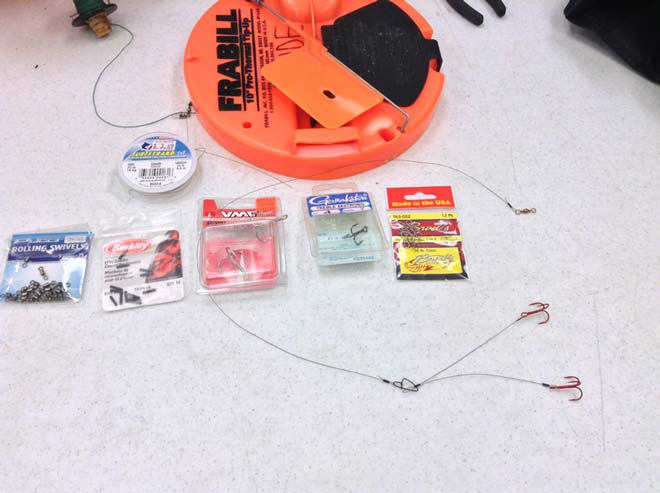
By Mike Lunde
Northern pike are one of the dominant piscivorous predators that roam Alaska’s freshwater lakes and river systems. During the ice fishing season, hardwater anglers utilize a twofold combination of vertical jigging techniques and tip-ups presentations to catch them. Compared to anglers targeting pike in lower 48 watersheds, there is an important difference as it applies to presenting bait on tip-ups in Alaska. The Alaska Department of Fish and Game (ADFG) regulations state that the use of live bait is illegal and this is done as a conservatory method to prevent the introduction of invasive species to Alaska’s native fish populations. Even though trophy sized northern pike have been caught on livebait, deadbait is still as equally effective. They represent a large, stationary profile to hungry fish, triggering instinctive strikes. As a bonus, the putrid smell given off is transported through underwater currents which allow pike to use their olfactory senses to locate the bait. With catch-and-release angling becoming increasingly popular, quick-strike rigs have been successful in minimizing post-release mortality and increasing hooking efficiency.
Quick-Strike Rig Philosophy
The introduction of quick-strike rigs came into play approximately 30 years ago, working off an elaborate European design. Although several variations in existence, these rigs shared a fundamental design: a hook attached to the end of a 15- to 20- inch section of wire with a second riding a few inches above. A typical northern pike bait rig consisted of a large single or treble hook attached to a wire or fluorocarbon leader with livebait or deadbait impaled on the hook. Although an effective presentation, it otherwise proved detrimental to the survival of post-released fish. This concept was demonstrated by the Wisconsin DNR on a population of muskies. Terry Margineau, a Wisconsin DNR (WIDNR) fisheries biologist published a study that demonstrated that large single-hook (#10/0) livebait rigs killed fish because anglers waited several minutes for fish to manipulate their prey thereby resulting in lacerations of the stomach cavity. The study concluded that quick-strike rigs are effective presentations for minimizing catch-and-release mortality. It was apparent that tandem-hook rigs maximized hooking efficiency for several reasons: (1) increased probability of hook-ups, (2) pike are hooked shallower in the mouth thereby making hook removal easier, and (3) angler can set the hook instantly, rather than letting the fish run – hence the term “quick-strike”.
Quick-Strike Rig Systems
Two hooks or tandem-hook designs remain the ideal standard for quick-strike rigging. The function of hooks on quick-strike rigs serves two purposes – to hold the bait and hook the pike. One hook of the treble is impaled through the bait, leaving the remaining two exposed for hook-ups. Hook positioning on quick-strike rigs is important because if not rigged properly the bait rides in unnatural position in the water column, thus resulting in low percentage hook-ups. Many ice anglers generally nose hook or dorsal fin hook bait, and the success rate of these single-hook rigs are exceptionally low. To properly rig deadbait, the end hook is inserted slightly behind the dorsal fin of the baitfish with the upper hook inserted near the tail. Depending on the length of the bait, the distance in between both hooks should be 2 to 4 inches. When selecting deadbait, choose oily baitfish that give off that putrid stench. Popular baitfish to select for deadbait include herring, smelt, sardines, least ciscoes, whitefish, and longnose suckers.
A variety of commercial manufacturers make quick-strike rigs that work for presenting deadbait, yet there is a problem as it pertains to the hook positioning. Fixed hook positioning results in deadbaits held in an unnatural, upright position. The quick-strike rigs presented here allow for a horizontal, natural deadbait presentation. Personal preferences for leader material vary between wire and flourocarbon. In clear water situations, flourocarbon is necessary despite the sharp teeth pike possess. Flourocarbon is much more abrasion resistance and has less stretch compared to monofilament which essentially means its fairly tooth resistant. For wire, titanium or sevenstrand stainless steel wire will suffice in for most water conditions.
Quick-Strike Rigging Formula
Select a 20 to 35 inch piece of wire or fluorocarbon, allowing a few inches for crimping. Insert one tag end through a crimp sleeve and slide up a few inches. Insert a barrel swivel onto the wire. While using your thumb as a guide, take that tag end piece of wire and reinsert it through again as you first began. Slide wire or flurocarbon through crimp sleeve and crimp very tight with pliers or crimping tool. The same process will be applied when attaching the cross-lock or dulock snap. Cut another 8 to 14 inch separate section of flurocarbon or wire. Insert crimp sleeve up both tag ends and slide it up until a small loop is formed. Once the small loop has been established, crimp the sleeve tight. The final step is crimping on two treble hooks of similar size. Follow the same crimping process as mentioned previously for the barrel swivel and cross-lock snap.
An additive bonus to provide on quick-strike rigs is a spinner. Since northern pike rely heavily on their sight and lateral line for feeding, the addition of spinners onto a quick-strike rig provides that acoustic vibration in the water column that simulates struggling prey. This alerts and triggers pike from longer distances to strike. Often this is a huge advantage during low-light conditions or reduced water clarity or else when a pike’s vision is obscured in dense, aquatic vegetation. To add spinners onto a quick-strike rig, directly thread the spinner on the wire just above the top hook. Add a quick-change clevis to interchange spinner blade type (e.g. Colorado, Indiana, or Willow-leaf blade) and colors. Popular spinner colors to experiment with include silver, gold, hot orange, and chartreuse.
As the baitfish length increases, the size of the treble hook increases. This table is a general comparison of hook size to baitfish length that should be used when constructing quick-strike rigs. By matching preferred hook size to correct baitfish length, the quick-strike rig maximizes hooking efficiency.
Baitfish length Hook Size
5-7 inches #2 to #1
8-10 inches #1/0 to #2/0
12-14 inches #2/0 and larger
View the full length video here.


